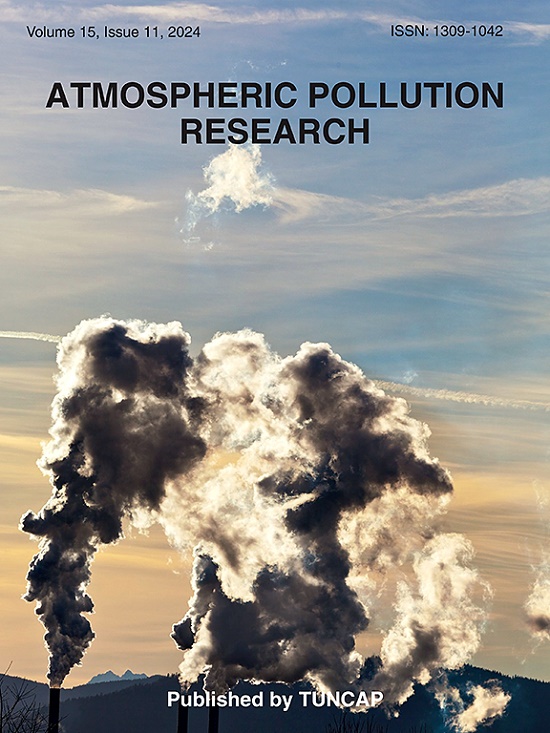济南市O3变化及vocs源对O3污染的综合分析
IF 3.5
3区 环境科学与生态学
Q2 ENVIRONMENTAL SCIENCES
引用次数: 0
摘要
虽然济南市夏季频繁出现严重的O3污染,强调了缓解O3污染的必要性,但O3污染事件的关键形成过程和主要来源特征尚不明确。采用天气研究与预报(WRF)-社区多尺度空气质量(CMAQ)模型系统,对济南市夏季O3污染的形成机制进行了研究。此外,随后应用综合源分配方法(ISAM)来确定导致O3水平升高的主要VOCs贡献者。在O3污染事件中,高海拔地区气化学作用产生的O3浓度增加通过垂直输送输送到地面,加剧了白天光化学反应引起的地表O3污染。行星边界层高度下降和垂直混合形成的富O3残余层是夜间近地表O3积累和增强的关键驱动因素。此外,ISAM结果表明,末端烯烃碳键(OLE)、内部烯烃碳键(IOLE)和乙烯(ETH)在O3的形成中起着至关重要的作用,总共贡献了60%。这意味着汽车尾气和液化石油气(LPG)和天然气(NG)在济南市的使用非常重要。研究结果为O3污染事件提供了可能的解释,并为O3来源分配提供了定量认识,指导了以O3缓解为导向的vocs控制策略。本文章由计算机程序翻译,如有差异,请以英文原文为准。
A comprehensive analysis of O3 variation and source contributions of VOCs-oriented to O3 pollution episodes over Jinan city, China
Although severe ozone (O3) pollution has been frequently observed during summer over Jinan city in northern China, which underscores the necessity of mitigating O3 pollution, the key formation processes and prominent sources of O3 pollution episode remain poorly characterized. In this study, the Weather Research and Forecasting (WRF)-Community Multiscale Air Quality (CMAQ) modeling system was employed to investigate the formation mechanism of O3 pollution during summer in Jinan. In addition, the Integrated Source Apportionment Method (ISAM) was subsequently applied to determine the major VOCs contributors to elevated O3 levels. During O3 pollution episodes, increased O3 concentrations generated by gas-chemistry at high altitudes were transported to the ground through vertical transport, exacerbating surface-level O3 pollution caused by photochemical reactions during daytime. The declined height of the planetary boundary layer (PBLH) and vertical mixing, which form O3-rich residual layers, were identified as the key drivers of the O3 accumulation and enhancement near the surface during nighttime. Furthermore, ISAM results indicate that terminal olefin carbon bonds (OLE), internal olefin carbon bonds (IOLE), and ethene (ETH) playing essential roles in O3 formation, collectively contributing up to 60 %. This implicates great importance of vehicle exhaust and the use of liquefied petroleum gas (LPG) and natural gas (NG) over Jinan city. Our findings offer possible explanations for O3 pollution episode and provide a quantitative understanding of O3 source apportionment, guiding the control strategy of VOCs-oriented on O3 mitigation.
求助全文
通过发布文献求助,成功后即可免费获取论文全文。
去求助
来源期刊

Atmospheric Pollution Research
ENVIRONMENTAL SCIENCES-
CiteScore
8.30
自引率
6.70%
发文量
256
审稿时长
36 days
期刊介绍:
Atmospheric Pollution Research (APR) is an international journal designed for the publication of articles on air pollution. Papers should present novel experimental results, theory and modeling of air pollution on local, regional, or global scales. Areas covered are research on inorganic, organic, and persistent organic air pollutants, air quality monitoring, air quality management, atmospheric dispersion and transport, air-surface (soil, water, and vegetation) exchange of pollutants, dry and wet deposition, indoor air quality, exposure assessment, health effects, satellite measurements, natural emissions, atmospheric chemistry, greenhouse gases, and effects on climate change.
 求助内容:
求助内容: 应助结果提醒方式:
应助结果提醒方式:


